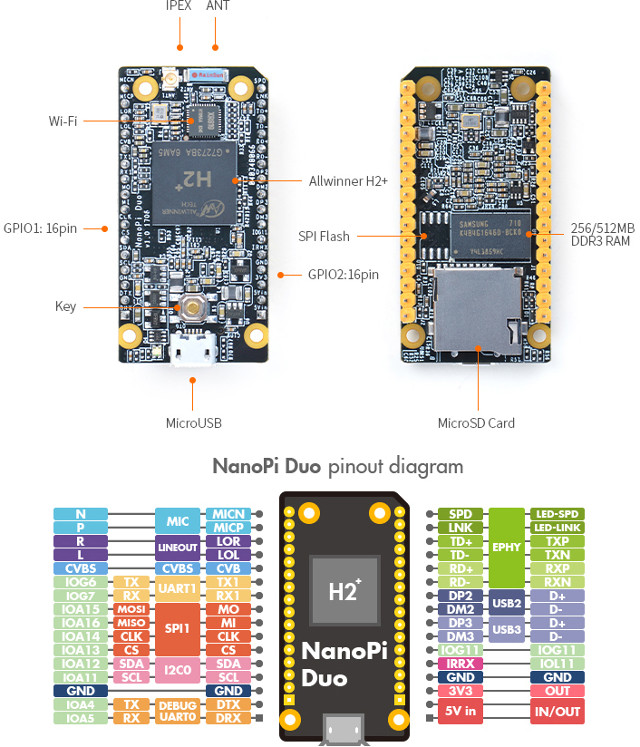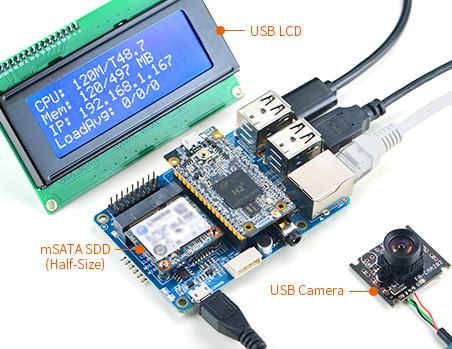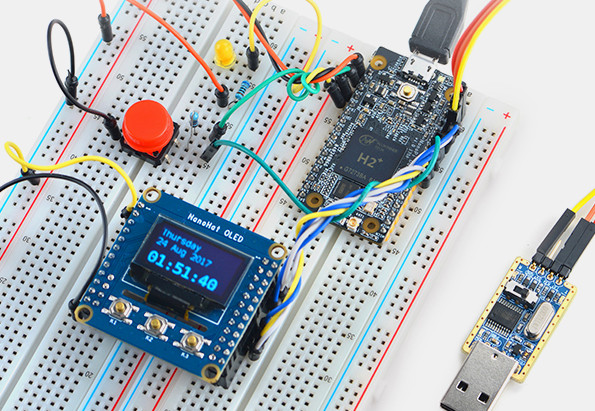It’s very easy to find breadboard compatible boards in the market with products based on Espressif chips such as NodeMCU or ESP32 boards, as well as OpenWrt board like Onion Omega2, or LinktIt 7688. However, it’s much more difficult to find powerful quad core boards in this form factor, but that’s exactly what FriendlyELEC has done with their NanoPi Duo board featuring an Allwinner H2+ quad core processor in a form factor slightly smaller than a Raspberry Pi Zero.
- SoC – Allwinner H2+ quad core Cortex A7 processor @ 1.2 GHz with Mali-400MP2 GPU @ 600 MHz
- System Memory – 256 or 512 MB DDR3-1866 SDRAM
- Storage – micro SD card slot, footprint for SPI flash
- Connectivity – 802.11 b/g/n WiFi (Allwinner XR819 module) with chip antenna, and u.FL/IPEX connector for external antenna
- USB – 1x micro USB OTG port
- Expansion headers – 2x 16-pin breadboard compatible headers with 2x USB host ports, GPIO, UART, SPI, I2C, MIC, Line Out, CVBS (composite video), Ethernet, 5V, 3.3V, and GND
- Misc – 1x key
- Power Supply – 5V via micro USB port
- Dimensions – 50 x 25.4 mm
- Weight – 7.76 grams with headers
- Temperature Range – -40°C to +80°C
 An optional heatsink covering most of the board has also being designed in order to deliver optimal performance under load.
An optional heatsink covering most of the board has also being designed in order to deliver optimal performance under load.
The company provides an image based on U-boot, Linux 4.11.2, and Ubuntu 16.04.2 Xenial for the board, which you can find in the Wiki, together with the rest of the software and hardware documentation including schematics (PDF) and mechanical design files.

In order to experiment the I/Os on the board, FriendleELEC also provides what they call “NanoPi Duo mini Shield” exposing the following interfaces:
- Storage – Half-size mSATA slot via JMS567 USB to SATA controller
- Connectivity – 1x 10/100M Ethernet port
- USB – 4x USB host port
- Audio – Built-in microphone, and 3.5mm audio jack
- Debugging – 4-pin connector for serial console
- Expansion – 2x 9-pin GPIO header with I2C, SPI, UART, and GPIO; 6-pin SPI header
- Misc – SSD and Power LEDs
- Power Supply – 5V via micro USB port
- Dimensions – 85 x 56 mm (Compatible with Raspberry Pi 3 cases)
Documentation for the mini shield is located in a separate wiki page.
NanoPi Duo sells for $7.99 with 256MB RAM, $11.99 with 512MB, plus shipping. You may consider adding the $2.99 option for the heatsink, and while you can also add the mini shield for $9.98, the “NanoPi Duo Starter Kit” may be a better option as it goes for $17.98 with all accessories you may need for a complete system.
Thanks to theguyuk for the tip.

Jean-Luc started CNX Software in 2010 as a part-time endeavor, before quitting his job as a software engineering manager, and starting to write daily news, and reviews full time later in 2011.
Support CNX Software! Donate via cryptocurrencies, become a Patron on Patreon, or purchase goods on Amazon or Aliexpress






One of these shitty Wifi modules without Linux support?
@Philipp Blum
My Orange Pi Zero is working fine.
I like, with the missing spi flash it could boot from mSATA, did this with Zero *USB boot”
@Philipp Blum
Friendly has a pretty good track record of releasing Linux images that work. They also have a fairly good track record of publishing updates to fix things that don’t work.
@Philipp Blum Gets mentioned on Linux-sunix.org as to driver locations. Allwinner Device Type sdio id sunxi-3.4 kernel mainline kernel XR819 SDIO 0020:2281 xradio_wlan For XR819 BSP driver can found here and firmware blobs can be found there or here. A more recent driver variant can be found at patch-add-support-xr819.tar.gz. Also some documentation is available now: File:XR819 Datasheet V1.0-EN.pdf and File:XR819 Application Guide V1.0-CH.pdf May be related to ST cw1XX0 [1]. Initial comparison between cw1200 (drivers/net/wireless/st/cw1200) and xradio driver shows that the source code for two drivers are really similar and the st1200 driver can be improved to support both devices.… Read more »
@theguyuk: once upon a time – went there, read it…
Came to the point where it comes out that cw1x00 doesn’t work either.
So seems AW bought some IP with crap SW support, now they have to sort it on their own
If they can.
What about considering this as a (much) more powerful alternative to ESP8266/NodeMCU? In that case, the shield expansions are not needed, and the compact form-factor remains 🙂
Nice combination. With Opi Zero and Wi-Fi active (powermanagent on) we managed to get idle consumption as low as 550mW with appropriate settings — shouldn’t be different here since same ingredients (H2+ and XR819). Already curious whether FriendlyELEC coders were able to improve xradio driver so the missing frame problem is maybe gone?
I hope the SPI NOR flash is at least 2MB in size as with the other sun8i boards. And the possibility to use internal mSATA storage (boot from SPI flash, rootfs on USB/mSATA) while being compatible to (industrial) RPi enclosures/add-ons is also a smart move 🙂
I like the idea. It may soon become an interesting alternative to nodemcu boards for certain use cases. Ie you want very low power draw and run a small program, you use an ESP8266, or you want to run more complex programs and are fine with using more power, and you can use this nanopi-duo. FWIW I’m currently playing with a nanopi-neo-air which is very small and reasonably power-efficient. I found it to consume almost not more than a WR703N and is suitable for running on (big) batteries. I noticed that it’s getting really close to what can be achieved… Read more »
I
(ha oops)
I’m excited about this. I’ve been putting off working with the Onion boards because of having to learn a new Linux. I run Ubuntu on my desktop and servers, and I would love something in this form factor that runs Armbian. A nice high-performance boost over the Arduinos I sometimes play with.
Based on the instructions at http://wiki.friendlyarm.com/wiki/index.php/Mainline_U-boot_%26_Linux using github https://github.com/friendlyarm/linux/tree/sunxi-4.11.y/drivers/net/wireless/st/cw1200 this driver is the old driver. Also, looked for xr819, nothing in the tree.
what ? no sata port ? meh..
jk, very nice of them to release this. A nice big brother to my esp
The mSATA on the mini shield might make this a great inexpensive headless device for apps that require heavy disk usages such as MySQL! OTOH, the cheapest half size mSATA I could find cost more than the combo! https://www.aliexpress.com/item/Zheino-Half-Size-mSATA-SSD-16GB-SATA-III-Mini-Half-Size-SATA3-SSD-Solid-State-Drive/32812222753.html Still, that makes the total cost around $40US.
Too bad the GPU is such a piece of turd. Seems interesting. I could imagine using in projects that connect to other micro controllers. Otherwise the CPU power is way too powerful for simple embedded projects. At this rate the Arduino/ESP clones will soon have octacore and several gigabytes of RAM. Then what?
@Jerry
All use cases involving computer vision and speech recognition can be handled by such a device and are way out of reach for ESP and arduino. So this board will really allow DIYers to build their own robots, surveillance systems, home assistants etc.
@Willy
ESP32-LyraT Audio Development Board is designed for “systems of artificial intelligence, voice and image recognition, wireless audio and smart-home networks.”: https://www.espressif.com/en/media_overview/news/espressif-joins-baidu%E2%80%99s-conversational-ai-platform-esp32-lyrat
Not sure which part is done in the board vs the cloud however.
I think this would be a cool platform to use with IncludeOS. Wish it had just a tiny amount of built-in storage
A regular-size mSATA thing should work as well I think, if you pin it down? There don’t seem to be any connectors in the way, though you’d have to cut the case up a bit I suppose.
Anyway I’m happy they’ve finally made a tiny board with cvbs output. Using the dock thing for setup would really save time and effort when setting up stuff like a portable gaming thing and whatnot.
Yay another board using XR819. Maybe having more people will actually improve the situation and someone will clean up the driver and put it to mainline.
Otherwise I predict more people complaining about poor performance and not being able to use mainline kernel. Maybe we will see NanoPi Duo+ with better WiFi chipset in the near future…
After I searched for reasonable half-size mSATA SSDs (almost none) I checked situation and unfortunately even with a custom enclosure you would have to remove the stand-offs before you could use a full-size mSATA card 🙁
https://forum.armbian.com/index.php?/topic/5035-nanopi-duo-plus-mini-shield/&do=findComment&comment=38362
Should be possible to use a right angle adapter to change the orientation, therefore use a full-size mSata SSD.
Still no FCC ID I see. Not going to touch it. Unusable for integrators, probably illegal to use by anyone else.
And with NEO Core/Core2 it gets even more interesting: https://forum.armbian.com/index.php?/topic/5035-nanopi-duo-plus-mini-shield/&do=findComment&comment=38574
According to device tree files in FriendlyELEC’s Github repo at least H3 based NEO Core is equipped with eMMC while Core2’s H5 is accompanied with an I2C accessible voltage regulator that allows H5 being clocked at up to 1368 MHz.
any eta for core/core2 or at least info eta? i was about to order stuff from friendly, but when i saw that “core” thingie i started having second thoughts… should i wait or should i not…
@tkaiser
Yeah a double-sided ssd will fit badly, but I don’t think you’d need to solder off the standoffs? I’ve made things like that work in the past, by just pinning the board down with double-sided tape or hot glue. Not pretty, but the connector does work with a slight angle (in my experience).
Otherwise a m.2 adapter is cheap and should do the job, one like this: https://www.aliexpress.com/item/M-2-B-Key-NGFF-SSD-to-Mini-pci-express-pcie-PCI-E-mSATA-Adapter-Add/32798005343.html
ahrlad : Otherwise a m.2 adapter is cheap and should do the job, one like this Yeah, M.2 B key should do the job. Couldn’t resist: http://kaiser-edv.de/tmp/WxcGwv/NanoPi_Duo2_mSATA_M2.jpg (custom enclosure needed) But based on my experiences with the only M.2 SSD I own (Transcend TS120GMTS420) a huge heatsink is needed anyway. I had this SSD in a small ‘USB thumb drive’ like enclosure and this thing then gets insanely hot (75°C internal thermal readout in idle and enclosure to hot to touch) and performance drops down from ~380 MB/s to just one-tenth. Lesson learned: looking for performance with those small things… Read more »
@tkaiser
Really? I use one of those m.2-USB adapter thumb things with a chinese m.2 2242 as hard drive for my home server, I never even thought about heat issues. Guess I’ll need to check it out, thanks for the warning.
@ahrlad
Well, at least the TS120GMTS420 is hot like hell (and refuses to enter sleep/standby — hdparm -y /dev/sda) and Igor reported over at Armbian forum the same for another such SSD he also wanted to put inside such a M.2-USB thingie. No way.
And I would not rely solely on SMART values since at least the Chinese M.2 SSD @Jean-Luc Aufranc (CNXSoft) tested recently fakes thermal readouts and reports 40°C all the time.
NanoPi Duo in action with breadboard powering, USB and Ethernet: https://forum.armbian.com/index.php?/topic/5035-nanopi-duo-plus-mini-shield/&tab=comments#comment-39876 (as expected pretty software compatible to OPi Zero since relying on same hardware components)
I see Friendlyelec are now stocking a Kingspec 64GB MiniPCIe mSATA Half Size SSD $45.00
@theguyuk
I hope FriendlyELEC fixes the absurd product description (there exist mPCIe and mSATA storage products, it’s always either/or and mentioning ‘miniPCIe’ when it’s (m)SATA in reality is highly misleading).
Besides that I would never buy flash storage products when vendor name contains the string ‘King’. 🙂
@tkaiser
@tkaiser
Do you know if they have the same pin connections or will it be necessary to provide an altered ftb, e.g. will the images made for OPi work with the NanoPi Duo without problems?
And today both NanoPi NEO Core and NEO Core 2 got their wiki pages: http://wiki.friendlyarm.com/wiki/index.php/Main_Page#NanoPC.2FPi_Series
Everything on pin headers (Gigabit Ethernet included with Core 2). The pin header layout is backwards compatible it seems but allows also for the new features. And there will be also appropriate shields making the stuff on the pin headers available: https://forum.armbian.com/topic/5035-nanopi-duo-plus-mini-shield/?do=findComment&comment=38574
‘Early 2018’ update on H2+/H3/H5 board overview: https://forum.armbian.com/topic/1351-h3-board-buyers-guide/?tab=comments#comment-44979
@tkaiser
I’m a little surprised there’s demand for such low end boards with M.2 SSD, for what application?
@Jean-Luc Aufranc (CNXSoft) I think it’s only space constraints. On the Mini Shield for NanoPi Duo there’s a half-length mSATA slot but mSATA SSDs of this size are not available from trustworthy vendors. There are more and ‘better’ SSDs in M.2-2242 form factor available so that’s a slight advantage. With ‘better’ I don’t mean more performant but good SMART data for example (no faked thermal values, health indication, GP/SMART Log 0x04 available and stuff like that). Since it’s still USB2-SATA there’s no need to choose fast SSDs, it’s even counterproductive since fast M.2 SSDs tend to overheat. But since the… Read more »